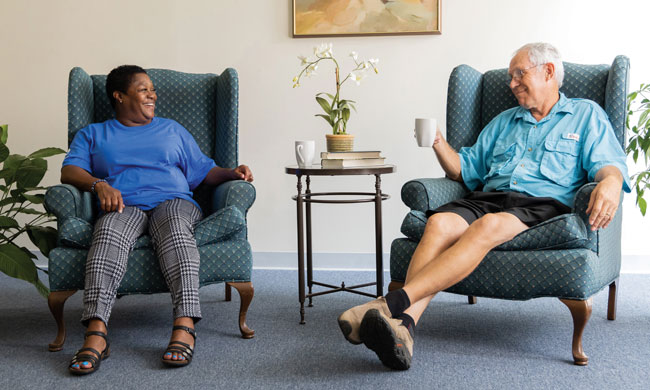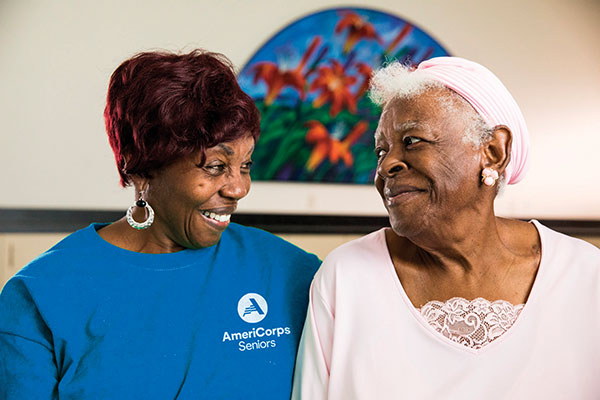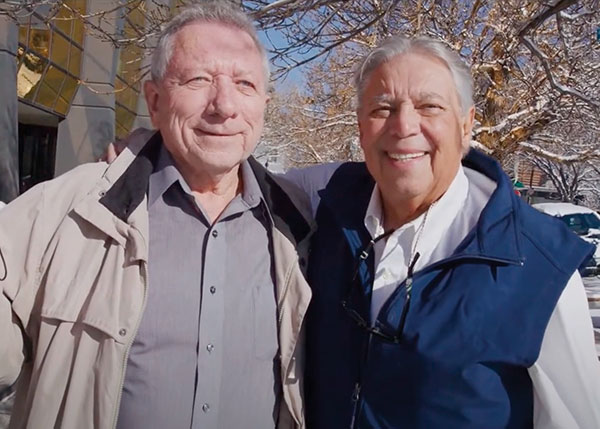Lifestyle
Combatting Loneliness in Older Adults
Last Updated on December 2, 2024 by Daily News Staff
(Family Features) The bonds found in friendships and other relationships are an important factor in health and wellness – even science says so.
According to the American Psychological Association, forming and maintaining social connections at any age is one of the most reliable predictors of a healthy, happy and long life. Studies show having strong and supportive friendships can fend off depression and anxiety, lower blood pressure and heart rates in stressful situations and change the way people perceive daunting tasks.
 However, statistics show approximately half of U.S. adults lack companionship and feel socially disconnected, according to the U.S. Surgeon General’s Advisory on the Healing Effects of Social Connection and Community. In fact, 12% don’t have anyone they consider a close friend, per the Survey Center on American Life. This “epidemic of loneliness,” as coined by U.S. Surgeon General Dr. Vivek Murthy, can take a severe toll on mental and physical health.
However, statistics show approximately half of U.S. adults lack companionship and feel socially disconnected, according to the U.S. Surgeon General’s Advisory on the Healing Effects of Social Connection and Community. In fact, 12% don’t have anyone they consider a close friend, per the Survey Center on American Life. This “epidemic of loneliness,” as coined by U.S. Surgeon General Dr. Vivek Murthy, can take a severe toll on mental and physical health.
As people age, the risks of isolation increase. With America’s older population growing rapidly – the 65 and older population reached more than 55 million in 2020 – discussing how older adults can combat loneliness is relevant to public health and individual well-being.
Consider volunteering, which is one of the best and most rewarding ways to combat loneliness.
Volunteering Combats Loneliness
People often volunteer to find a sense of purpose, learn new skills, improve their communities or establish new routines after retiring or becoming empty nesters. For many, making friends through volunteer work is a welcome bonus. The act of volunteering provides proven benefits for older adults.
Forming connections can make all the difference in a person’s volunteer experience and sense of well-being. People who meet through volunteer work inherently share a common interest and something to bond over. These friendships can carry over outside of volunteer work and lead to bonding over other hobbies and interests.
Connection-Focused Volunteer Opportunities
In addition to making friends with fellow volunteers, many older adults also form relationships with the people they’re serving, especially if those recipients are their peers.
For example, AmeriCorps Seniors is the national service and volunteerism program in the federal agency of AmeriCorps that connects adults aged 55 and up to local service opportunities that match their interests. Its Senior Companion Program pairs volunteers with other older adults or those with disabilities who need companionship or assistance. Volunteers may help with tasks such as paying bills, shopping or getting companions to appointments. In some cases, volunteers may also provide support and respite for family members caring for loved ones with chronic illnesses.
“We often think of volunteering as ‘giving back,’ but we’ve seen firsthand that it often becomes so much more than that,” said Atalaya Sergi, director of AmeriCorps Seniors. “By spending a few hours each week with another older adult in need of support, our volunteers are not only giving back to others, but they’re adding meaning to their own lives and establishing new connections. They’re helping to fight the loneliness epidemic one visit at a time.”
Growing older can come with challenges, but some of those can be minimized with a positive mindset and commitment to remaining connected and engaged – whether with friends, relatives or fellow community members. Fostering relationships is a key ingredient to a healthier and more fulfilling life.
For more information and to find volunteer opportunities near you, visit AmeriCorps.gov/YourMoment.
Meet Friends Who Connected Through Service
 Ray Maestas felt unfulfilled post-retirement and began volunteering with the AmeriCorps Seniors Senior Companion Program. He was connected with Bob Finnerty, a man with blindness looking for assistance a few days each week. They quickly struck up a routine of errands, reading and conversation that’s since become a friendship they both cherish.
Ray Maestas felt unfulfilled post-retirement and began volunteering with the AmeriCorps Seniors Senior Companion Program. He was connected with Bob Finnerty, a man with blindness looking for assistance a few days each week. They quickly struck up a routine of errands, reading and conversation that’s since become a friendship they both cherish.
“The Senior Companion Program has provided an avenue to enrich the lives of not only the participants but the people who are volunteering,” Maestas said. “Bob and I have gotten to the point where he’s a very important part of my life.”
Finnerty echoed those sentiments and shared his own appreciation for Maestas’ friendship.
“I’ve always relished my independence and I feel Ray is not just a person who reads for me – he’s a friend,” Finnerty said.
In the last few years, Maestas moved and now serves with a different chapter of the Senior Companion Program. He and Finnerty keep in touch. Maestas said they talk about every third day.
SOURCE:
AmeriCorps Seniors
Discover more from Daily News
Subscribe to get the latest posts sent to your email.
Stories of Change
The Holiday Spirit Matters But So Does What Happens After
The Holiday Spirit: Holiday generosity is powerful, but community needs don’t end when the decorations come down. Learn practical ways to give back year round—volunteering, donating, sharing skills, and supporting causes you believe in—with help from United Way.

The Holiday Spirit Matters — Why Giving Back Should Last All Year
(Family Features) During the holiday season, many people feel a renewed sense of generosity. It’s a time when communities come alive with food drives, toy collections, volunteer events and donation campaigns – all fueled by the spirit of giving. While this seasonal energy can be powerful, the need it responds to doesn’t fade when the decorations come down. Giving back is not only essential during the holidays; it’s also the foundation of stronger, more resilient communities year round. People in nearly every community face challenges – whether it’s affording holiday presents or meeting basic needs like food, rent and utilities. For many families, current economic strains are forcing them to make tough decisions like sacrificing necessities or depleting savings to create moments of holiday joy. This is a time to rally support and help neighbors in need. Right now, many community members who didn’t previously need help are seeking support. Acts of generosity large and small help close gaps and strengthen communities. When individuals and businesses give their time, resources and talent, they can help ensure everyone has a fair chance to not only survive but thrive. Communities rely on nonprofit organizations like United Way – one of the oldest and largest organizations committed to tackling local challenges and mobilizing communities to improve lives. With a presence in nearly 99% of communities across the U.S., the organization recognizes the power of giving and relies on seasonal and year-round generosity to deliver food and housing assistance, youth programs, mental health support, disaster recovery and more. This holiday season and beyond, to assist your community consider taking actions such as: Volunteering Offering your time is one way to make a real change in your community while helping build a more resilient future for all. What’s more, research shows the personal benefits of volunteering, such as reduced feelings of isolation, loneliness and risk of depression. Whether it’s a community event, ongoing support or in-person activities, making a difference for others feels good. Donating Sharing your financial resources can play a vital role in helping communities thrive. Your donation can help put food on the table for families in need, support kids who are struggling or provide mental health services to the most vulnerable individuals. Remember, your gift of any size combines with the gifts of others and builds stronger, more resilient communities. Sharing Expertise or Talent Generosity can take many forms. Making a difference isn’t just about time and money; it can also mean sharing skills or knowledge, and even social networks to bolster charitable efforts. Giving back builds a shared sense of responsibility. It reminds people that strong communities don’t happen by accident – they’re created through connection, compassion and collective action. Supporting Causes You Believe In Every community faces their own unique, pressing challenges and almost everyone has a cause that’s close to their hearts. Identify organizations working to advance those causes and make a plan to support them. Find opportunities to support your community this holiday season and make generosity a year-round tradition at unitedway.org/local.
This is a time to rally support and help neighbors in need. Right now, many community members who didn’t previously need help are seeking support. Acts of generosity large and small help close gaps and strengthen communities. When individuals and businesses give their time, resources and talent, they can help ensure everyone has a fair chance to not only survive but thrive. Communities rely on nonprofit organizations like United Way – one of the oldest and largest organizations committed to tackling local challenges and mobilizing communities to improve lives. With a presence in nearly 99% of communities across the U.S., the organization recognizes the power of giving and relies on seasonal and year-round generosity to deliver food and housing assistance, youth programs, mental health support, disaster recovery and more. This holiday season and beyond, to assist your community consider taking actions such as: Volunteering Offering your time is one way to make a real change in your community while helping build a more resilient future for all. What’s more, research shows the personal benefits of volunteering, such as reduced feelings of isolation, loneliness and risk of depression. Whether it’s a community event, ongoing support or in-person activities, making a difference for others feels good. Donating Sharing your financial resources can play a vital role in helping communities thrive. Your donation can help put food on the table for families in need, support kids who are struggling or provide mental health services to the most vulnerable individuals. Remember, your gift of any size combines with the gifts of others and builds stronger, more resilient communities. Sharing Expertise or Talent Generosity can take many forms. Making a difference isn’t just about time and money; it can also mean sharing skills or knowledge, and even social networks to bolster charitable efforts. Giving back builds a shared sense of responsibility. It reminds people that strong communities don’t happen by accident – they’re created through connection, compassion and collective action. Supporting Causes You Believe In Every community faces their own unique, pressing challenges and almost everyone has a cause that’s close to their hearts. Identify organizations working to advance those causes and make a plan to support them. Find opportunities to support your community this holiday season and make generosity a year-round tradition at unitedway.org/local. Nourishing Our Heroes: Eight Years of Impact at Phoenix VA’s Veggies for VeteransLink: https://stmdailynews.com/nourishing-our-heroes-eight-years-of-impact-at-phoenix-vas-veggies-for-veterans/
Stories of Change: People Making a Difference
Discover inspiring stories of changemakers making a positive impact. Explore videos and articles of people tackling today’s biggest challenges with action and hope. Visit: https://stmdailynews.com/stories-of-change/
STM Daily News is a multifaceted podcast that explores a wide range of topics, from life and consumer issues to the latest in food and beverage trends. Our discussions dive into the realms of science, covering everything from space and Earth to nature, artificial intelligence, and astronomy. We also celebrate the amateur sports scene, highlighting local athletes and events, including our special segment on senior Pickleball, where we report on the latest happenings in this exciting community. With our diverse content, STM Daily News aims to inform, entertain, and engage listeners, providing a comprehensive look at the issues that matter most in our daily lives. https://stories-this-moment.castos.com/
Discover more from Daily News
Subscribe to get the latest posts sent to your email.
Last Updated on December 18, 2025 by Daily News Staff

Keeping Pets Safe This Holiday Season: 5 Festive Safety Tips for Pet Owners
(Family Features) The holiday season brings sparkling lights, cherished traditions and joyful gatherings with the people and pets you love most. As you deck the halls and prepare for cozy celebrations, it’s important to remember some of the magic of the season can also pose risks for curious cats and dogs. To provide pet owners added peace of mind, consider these tips from the experts at VCA Animal Hospitals, a leader in veterinary care with more than 1,000 locations dedicated to positively impacting pets, people and the communities they serve, to keep the holidays merry – and safe – for everyone. Decorations and Festive Outfits From family photos to holiday cards, many pet owners love including their companions in the festivities. If you dress your pet for pictures, choose outfits that are comfortable, allow easy movement and don’t interfere with breathing or vision. Pets are naturally drawn to shiny and dangling decor, so opt for shatterproof ornaments and avoid using tinsel, which can cause serious internal issues if swallowed. Hang small or salt-dough ornaments high on the tree, out of paws’ reach, to help prevent choking. After opening gifts, promptly discard wrapping paper, string and ribbon; items that may seem fun to play with but can be dangerous if ingested. Food and Drinks Holiday tables overflow with delicious treats, but many seasonal foods can be harmful to pets. Chocolate, grapes, raisins, xylitol-sweetened candies and leftover meat scraps may lead to serious illness. Politely remind guests not to slip your pet any treats, no matter how festive the occasion feels. Quickly pack away food when meals end to help reduce temptation. Alcoholic beverages should also be kept well out of reach. Pets absorb alcohol much faster than humans, and even small amounts can cause alcohol poisoning. Candles and Burns The glow of candles and warm fireplaces add comfort and charm this time of year, but open flames pose fire risks and burn hazards for pets. Keep pets at a safe distance from fireplaces, wood stoves and space heaters, as curiosity can bring them too close. Consider using battery-operated candles in place of traditional ones. If you use real candles, ensure they’re placed out of reach and never left unattended; even stepping away for a moment can increase the risk of accidents. Plants and Trees Holiday greenery brings beauty to your home, but some plants require extra caution around pets. While Christmas trees themselves are generally non-toxic, the water in the tree stand may contain mold, bacteria or fertilizers. Use a tree skirt or cover to prevent pets from drinking from it. Decorative plants like poinsettias, mistletoe, lilies, holly and amaryllis can cause gastrointestinal upset if nibbled on. Keep these seasonal favorites well out of reach, especially if you live with adventurous or plant-curious pets. Cold Weather Walking Winter walks can be refreshing for you and your dog, but shorter days and colder weather mean extra care is needed. Use a non-retractable leash during early morning or evening walks, and ensure both you and your pet wear high-visibility gear so drivers and others can easily spot you.
If you live in an area with snow or ice, monitor conditions closely and watch the wind chill. Dressing your dog in a warm sweater or jacket and offering booties for paw protection can help them stay comfortable and safe on frosty outings. By taking a few thoughtful precautions, you can help ensure your pets enjoy a safe, joyful holiday season right alongside the rest of the family. If you have questions about winter safety or your pet’s health, consult your veterinarian. For more tips to keep your pet safe this holiday season, and to find a location near you, visit vcaholiday.com. Photos courtesy of Shutterstock
Food and Drinks Holiday tables overflow with delicious treats, but many seasonal foods can be harmful to pets. Chocolate, grapes, raisins, xylitol-sweetened candies and leftover meat scraps may lead to serious illness. Politely remind guests not to slip your pet any treats, no matter how festive the occasion feels. Quickly pack away food when meals end to help reduce temptation. Alcoholic beverages should also be kept well out of reach. Pets absorb alcohol much faster than humans, and even small amounts can cause alcohol poisoning. Candles and Burns The glow of candles and warm fireplaces add comfort and charm this time of year, but open flames pose fire risks and burn hazards for pets. Keep pets at a safe distance from fireplaces, wood stoves and space heaters, as curiosity can bring them too close. Consider using battery-operated candles in place of traditional ones. If you use real candles, ensure they’re placed out of reach and never left unattended; even stepping away for a moment can increase the risk of accidents. Plants and Trees Holiday greenery brings beauty to your home, but some plants require extra caution around pets. While Christmas trees themselves are generally non-toxic, the water in the tree stand may contain mold, bacteria or fertilizers. Use a tree skirt or cover to prevent pets from drinking from it. Decorative plants like poinsettias, mistletoe, lilies, holly and amaryllis can cause gastrointestinal upset if nibbled on. Keep these seasonal favorites well out of reach, especially if you live with adventurous or plant-curious pets. Cold Weather Walking Winter walks can be refreshing for you and your dog, but shorter days and colder weather mean extra care is needed. Use a non-retractable leash during early morning or evening walks, and ensure both you and your pet wear high-visibility gear so drivers and others can easily spot you.
If you live in an area with snow or ice, monitor conditions closely and watch the wind chill. Dressing your dog in a warm sweater or jacket and offering booties for paw protection can help them stay comfortable and safe on frosty outings. By taking a few thoughtful precautions, you can help ensure your pets enjoy a safe, joyful holiday season right alongside the rest of the family. If you have questions about winter safety or your pet’s health, consult your veterinarian. For more tips to keep your pet safe this holiday season, and to find a location near you, visit vcaholiday.com. Photos courtesy of Shutterstock Keeping Pets Safe This Holiday Season: 5 Festive Safety Tips for Pet Owners
SOURCE: VCA Animal HospitalsThe fate of Lucky Supermarkets in SoCalLink: https://stmdailynews.com/the-fate-of-lucky-supermarkets-in-socal/
Discover more from Daily News
Subscribe to get the latest posts sent to your email.
Family
5 Tips to Pull Off Holiday Hosting
With stay-at-home holidays a thing of the past for many families, they’re now busy preparing for full-blown celebrations. The return of traditional festivities brings seemingly never-ending to-do lists and pressure to be the perfect host.
Last Updated on December 17, 2025 by Daily News Staff
(Family Features) With stay-at-home holidays a thing of the past for many families, they’re now busy preparing for full-blown celebrations. The return of traditional festivities brings seemingly never-ending to-do lists and pressure to be the perfect host.
From mastering a mouthwatering menu and donning your home with decadent decor to ensuring guests enjoy the evening to the fullest, hosting duties bring plenty of responsibilities. This year, though, you can avoid those anxious feelings with some preparation ahead of the big day.
To help pull off a sensational seasonal soiree, consider these tips from the entertaining experts at Sun-Maid to make the holidays brighter and more manageable so you can navigate the stresses of hosting.
Invite Others to Share Favorite Traditions
Especially with stay-at-home holidays in recent years, some friends and family members may have developed their own special traditions from new recipes and foods to seasonal games and activities. Inviting your guests to bring or share something that represents their favorite part of the holidays can help everyone feel welcome.
Take Time for Yourself
Remember to make time for yourself so you can enjoy the fruits of your labor right alongside guests. The busyness of this time of year can add stress but reflecting on the true meaning of the season and reveling in your favorite parts of the holidays can help you avoid feeling overwhelmed.
Add New Ingredients to Your Menu
While pairing this year’s turkey or ham with the classics provides comfort and calls to mind holiday memories of the past, cooking with new ingredients and adding fresh recipes to the menu can put a fun spin on the season and maybe even create your own traditions to carry forward.
For example, baking with an option like Sun-Maid Raisins provides a whole fruit option with zero grams of added sugars per 1/4-cup serving. They’re an easy, better-for-you substitution to reduce overall sugar intake without compromising flavor or texture when compared with dried cranberries, which contain 27 grams of added sugars per 1/4-cup serving. The natural sugars of raisins make them a versatile, useful addition to a wide variety of holiday-worthy dishes.
Hop On Hot Food Trends
One of this year’s most popular trends in the kitchen is food boards, a fun and easy way to elevate flavor while incorporating favorites like cured meats, cold cuts, cheese slices and cubes, dips, nuts and more. Plus, you can keep your board balanced with nutritious items like vegetables and fruit, such as raisins, which provide sweet flavor without the added sugars.
A Time for Truce
Gathering for the holidays is about coming together with loved ones, family, friends and neighbors – and pulling it off means catering to everyone’s needs and wants. It’s a time for compromises and truces. To help add a little extra spark this year, try incorporating a theme to the party or coordinate fun activities and games that can be enjoyed by all. For example, holiday-themed charades, a seasonal “name that tune” game and gift exchanges all give guests ways to get in on the excitement.
To find more holiday entertaining inspiration and recipe ideas, visit SunMaid.com/PullOffTheHolidays .
Photos courtesy of Getty Images
SOURCE:
Sun-Maid Raisins
Discover more from Daily News
Subscribe to get the latest posts sent to your email.

